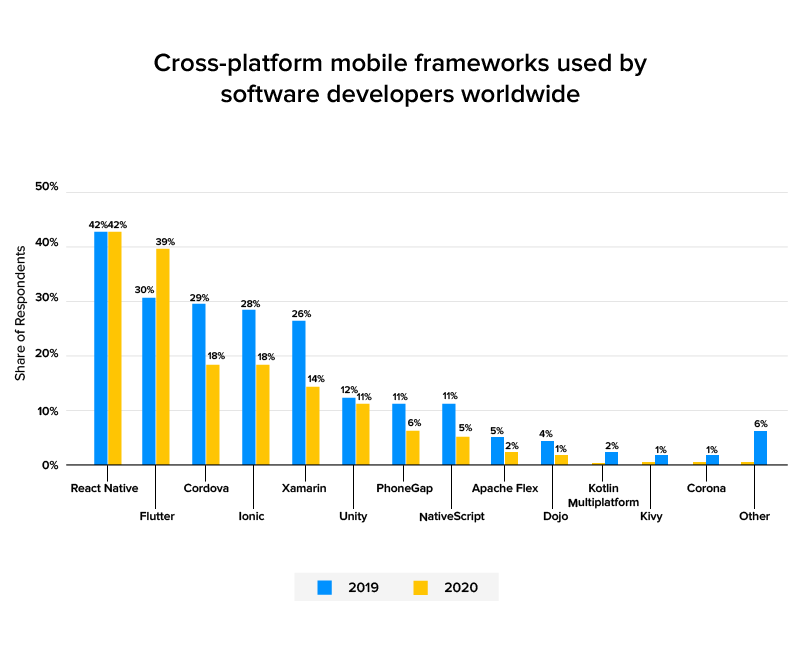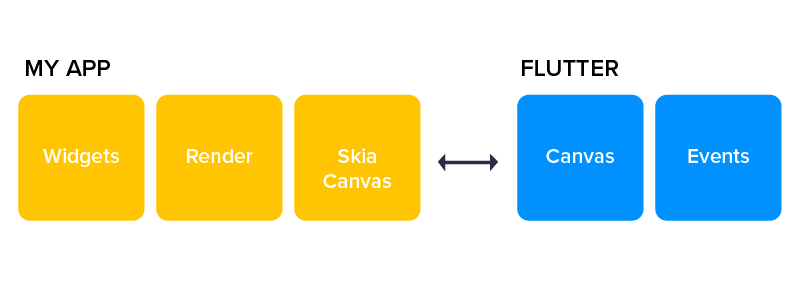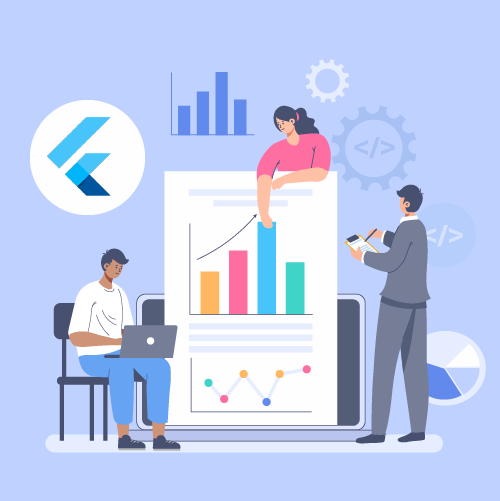Is Flutter Future-ready for Enterprise Apps?
Flutter is the future of app development that requires a platform with UI and support like native apps and capabilities like cross-platform apps.
Flutter is king, or at least it will be when it comes to enterprise application development. This is the overwhelming anthem of voices rising from the helm of the mobile app development industry.
As per Google, 500,000 developers use its software development kit monthly. Most of the time the question comes up about what to choose Flutter or React native. With a rising popularity share, Flutter is rubbing shoulders with its closest rival React Native, and will soon overtake it courtesy of the renewed interest from Enterprise mobile app developers.

But why is that?
In this article, we’ll offer our take on the motion that mobile app development using flutter is getting serious, and for good!
What Exactly is Flutter?
Flutter is a cross-platform, open-source UI software development toolkit. Its codebase offers a schema of functionalities applicable to not just iOS and Android, but also to Windows, Linux, Mac, and Google Fuchsia, not to mention the World Wide Web. Apps developed in flutter are coded in Google’s object-oriented language, Dart.
The question arises, why Dart?
That’s because it offers feasibility factors such as a higher productivity time for developers and an equally robust, object-oriented build for apps.
Platform-agnostic software development is marked with hurdles like an inefficient UI, a fast-aging source code, lack of security layers, native functionalities, and so on. Apps developed in Flutter bypass these problems with ease.
Enterprise Mobile App Development
As the name suggests, enterprise apps are engineered for the limited, and protected use of and by the enterprise workforce. Admins can moderate the data centrally, implement wide-scale automation, and adopt an event-driven approach when need be. The cry for app development using Flutter is catching fire because the framework has a war chest of more than 4000 libraries that can be used to build apps.
But is that reason enough to vouch for apps built with flutter?
Of course not!
Let us put forward the points and weigh the upsides of Flutter enterprise IT software that renders hybrid coding useless. The following sections elaborate on the universal requirements of enterprise mobile apps. We’ll try and outline the causes why an enterprise dependency on Flutter in mobile app development is a lucrative one!
Layered architecture
An enterprise app architecture is leveled with separate but interconnected layers concerning presentation, service, business, and data access. When such separation is interposed, developers must work out ways to offer the following:
- Enterprise-wide collaboration between teams
- Coding the app on validated, documented designs
- Easy-to-understand and use app-functionalities
When the architecture accounts for such usability aspects, then the working environment automatically translates into a well-oiled, highly productive engineering machinery.
Programmers who use Flutter for enterprise mobile apps, get secure networking gateways to resources hosted on the web. In wake of this, comes the following functionalities as well:
- Local storage
- Sqlite databases
- State management
- Dependency injection
- Background processing
- JSON serialization/deserialization
- Deep linking

Development environment
Flutter is integrable with Visual Studio Code and or Intellij/Android Studio. Leading OS formats such as Mac, PC, Linux, and Chromebook support the same for the purpose of designing, debugging, deploying, and troubleshooting.
Flutter runs on Dart. This object-oriented language can be used to import Dart packages that can offer the functionality of external libraries. When the team plans to build enterprise mobile apps using Flutter, the project can be repurposed with Flutter Dart packages providing an alternative to distribute responsibilities amongst team members.
Flutter is pre-packaged with 3 test frameworks namely Unite Test, Widget Test, and Integration Test. Designers can test widgets and each non-UI code byte with the aforementioned frameworks which gives them the ability to maximize their test coverage.
Flutter’s innate layout has been designed using the toolsets powering Android and iOS, which are required to deploy apps on the respective flagship app stores. Therefore, continuous integration and continuous delivery demanded by enterprise mobile apps will not be a pain point.
Having the working knowledge of native platforms is considered a prerequisite for developers working on enterprise mobile apps using flutter.

User interface
Experts believe that if not the architecture, then the success of an enterprise app certainly comes down to its user interface. However, in this sector as well Flutter stands its ground with functionalities of Material Widgets for Android and Cupertino Widgets for iOS platforms.
UI/UX designers can introduce animations with the use of Flare i.e. a 2-dimensional vector animation library. Transitioning between in-app pages can also be accomplished. While on the topic, a particular Flutter Charting Library warrants special mention using which data can be presented as pie charts, bar graphs, etc.
Today, the trend in Flutter mobile app development services are well within their scope of work to introduce infinite scrolling for rich content repositories. Also, populating Flutter enterprise apps are images that can be managed through Image loading and the caching library.
Finally, you can even provide access to Google and Apple Maps on a Flutter mobile application.

Hardware
Permission to access mobile hardware is common practice for apps. It is majorly done to facilitate operations such as document upload and location tracking. If you are developing android apps with Flutter app development, access to the following hardware components is now possible:
- Accelerometer
- GPS
- Biometric Authentication
- Camera
- NFC
Security
Security is an area that cannot be left loose. There are divisions to it that Flutter does justice to, which coincidentally are also the most prioritized security concerns for developers. It would not be wrong to say that Flutter is a spin-off of the Android and iOS sandbox environments. That’s why android and iOS developers consider flutter for app development.
This presumption gives rise to the theory that apps built using this framework harness the security features of native Android and iOS platforms.
At Appinventiv, we constitute our Flutter app development services with some of the brightest minds in the field. Our experience validates that authentication gateways can be well-managed on Flutter. They’ve used SimpleAuth to incorporate authentication channels with the following vendors:
- Amazon
- Dropbox
- Github
- Azure Active Directory
SSL certificates which have become something of an industry-standard can be pinned in the apps, mitigating the chances of a man-in-the-middle-attack. The SSL protocol migrates HTTP to an HTTPS and encrypts end-to-end data. The corresponding SSL certificate aids in identifying the credibility of the site owner and establishing consumer trust.
Hackers have come up with lethal ways to locate digital openings by reverse-engineering the app code. But the chances of that are grim with the Flutter Dart Code as the same compiles to ARM binary code. Developers can further complicate things for digital adversaries by using code obfuscation techniques.
Miscellaneous requirements
So far, we’ve discussed those areas that are the most prioritized by software developers. Then again, this isn’t it!
There is an intermix of overhead applications that have to be named.
- Analytics – Adobe and Firebase, the leading vendors in the analytics ecosystem have libraries supported by Flutter.
- Flutter apps can be used to generate and scan QR codes.
- Since the apps are cross-platform compatible, data sharing with Facebook, Twitter, etc. is possible.
- You can send and receive SMS and MMS messages
- With the integration of payment gateways, you can accept payments by connecting a card reader with the help of Square Reader SDK.
- You can even play music and audio in Flutter apps.
Some of the leading tech giants of the world are using Flutter. This includes names like Stadia, Google’s cloud gaming service, Square, Tencent, Google Assistant, eBay, and Emaar.
Other Benefits of Flutter
As a Flutter app development company, we feel the need to share the following added advantages you get with this open-source tool kit:
- Code development is fast
- The UI and code logic need not change regardless of the platform
- Product development can be speeded up to enter the market quicker
- Apps resemble native apps, closely if not perfectly
- It has a separate rendering engine
- It reduces the risk exposure for businesses
Final Thoughts
Flutter for app development platforms is a viable option not only for organizations looking for one-time app development, but also for various businesses, tech firms, startups, and individual developers. Appinventiv is a place where you can hire Flutter app developers at affordable prices.
If you want more clarity, you can take a minute and go through our line of work!

strategies your digital product..



